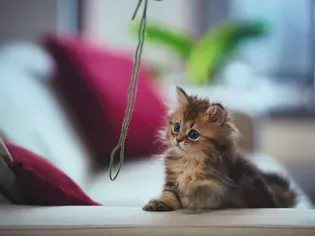Why Yarn Is Not a Safe Toy for Cats
Updated on 04/26/24

Yarn: A Seemingly Innocent Threat to Your Feline Friend
In the feline world, yarn holds an allure that is undeniable. With its soft texture and enticing movement, it beckons cats to engage in playful pursuits. However, beneath this seemingly harmless facade lurks a hidden danger that cat owners must be aware of. Yarn, if ingested, can pose serious health risks to our beloved companions, potentially leading to life-threatening complications.
The Allure of Yarn
Cats are instinctively drawn to yarn for several reasons:
* Texture: Yarn's soft, fibrous texture provides a pleasing sensation against their whiskers and paws, triggering their natural hunting instincts.
* Movement: The movement of yarn, whether it's being swayed or dragged, mimics the behavior of prey, further stimulating their predatory responses.
* Noise: The rustling sound of yarn can also pique a cat's curiosity, making it an irresistible toy.
The Dangers of Ingestion
While playing with yarn may seem like a harmless activity, ingestion can have severe consequences:
1. Gastrointestinal Obstruction: Yarn, when swallowed, can become entangled in the digestive tract, forming a foreign body obstruction. This blockage can prevent food and fluids from passing through, leading to vomiting, diarrhea, and abdominal pain.
Example: A 3-year-old domestic shorthair named Mittens was rushed to the vet after prolonged vomiting and lethargy. X-rays revealed a large mass of yarn obstructing her small intestine, necessitating emergency surgery to remove it.
2. Intestinal Perforation: The rough edges of yarn can also cause lacerations or perforations in the intestinal wall. This can lead to bacterial infection, peritonitis (inflammation of the abdominal lining), and even sepsis.
Example: A 5-month-old kitten named Oliver was found lethargic and in distress. Examination revealed a perforation in his small intestine caused by ingested yarn, requiring abdominal surgery to repair the damage.
3. Esophageal Obstruction: Yarn can also become lodged in the esophagus, causing difficulty breathing and swallowing. If not addressed promptly, this obstruction can lead to esophageal rupture or aspiration pneumonia.
Example: A 2-year-old Siamese cat named Cleo presented with sudden respiratory distress. Endoscopic examination revealed a ball of yarn entangled in her esophagus, which was successfully removed.
4. Choking: In severe cases, ingested yarn can cause choking, especially in young or small cats. The yarn can obstruct the airway, leading to respiratory distress and potential death.
Example: A 6-week-old kitten named Pip was found unresponsive after playing with yarn. Tragically, despite immediate veterinary intervention, the kitten passed away from yarn-related choking.
Prevention is Critical
To safeguard our feline friends, it is crucial to take preventive measures:
* Keep Yarn Out of Reach: Store yarn and other linear materials in a secure, inaccessible location where cats cannot reach them.
* Supervise Playtime: When allowing cats to play with toys, closely supervise their activities to prevent ingestion or entanglement.
* Choose Safe Toys: Opt for cat-safe toys made from non-absorbable materials, such as rubber, plastic, or fabric.
* Regular Check-ups: Schedule regular veterinary check-ups to monitor your cat's health and detect any potential yarn-related issues early on.
If Ingestion Occurs
In the unfortunate event that your cat ingests yarn, immediate veterinary attention is essential:
* Call Your Veterinarian: Contact your veterinarian immediately, regardless of how much yarn your cat has consumed.
* Observe Your Cat: Monitor your cat closely for any symptoms, such as vomiting, diarrhea, lethargy, or difficulty breathing.
* Bring Evidence: If possible, bring a sample of the ingested yarn to the veterinarian for identification.
Remember, yarn is not a safe toy for cats, and its ingestion can have potentially life-threatening consequences. By following these preventive measures and seeking prompt veterinary care if necessary, we can protect our furry companions from the hidden dangers of this seemingly innocent plaything.
Explore More Pets

Cat Behavior Problems
How to Stop Aggression in Kittens

Long-Haired Cat Breeds
Siberian Cat: Breed Profile, Characteristics, & Care

Cat Behavior Problems
How to Stop Kittens From Scratching and Biting

Long-Haired Cat Breeds
Turkish Angora: Cat Breed Profile, Characteristics & Care

Basic Training
How to Socialize Your Kitten

Short-Haired Cat Breeds
Cute Pictures & Facts About Calico Cats & Kittens

Litter Box Training
Training Your Kitten to Use the Litter Box

Long-Haired Cat Breeds
10 Fun Facts About White Cats